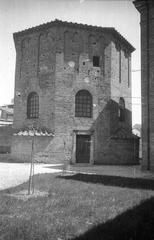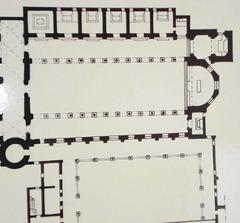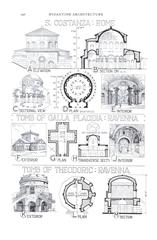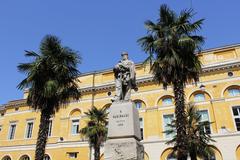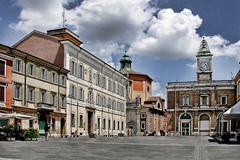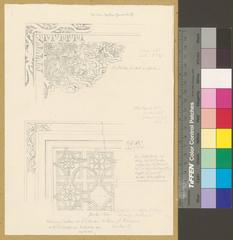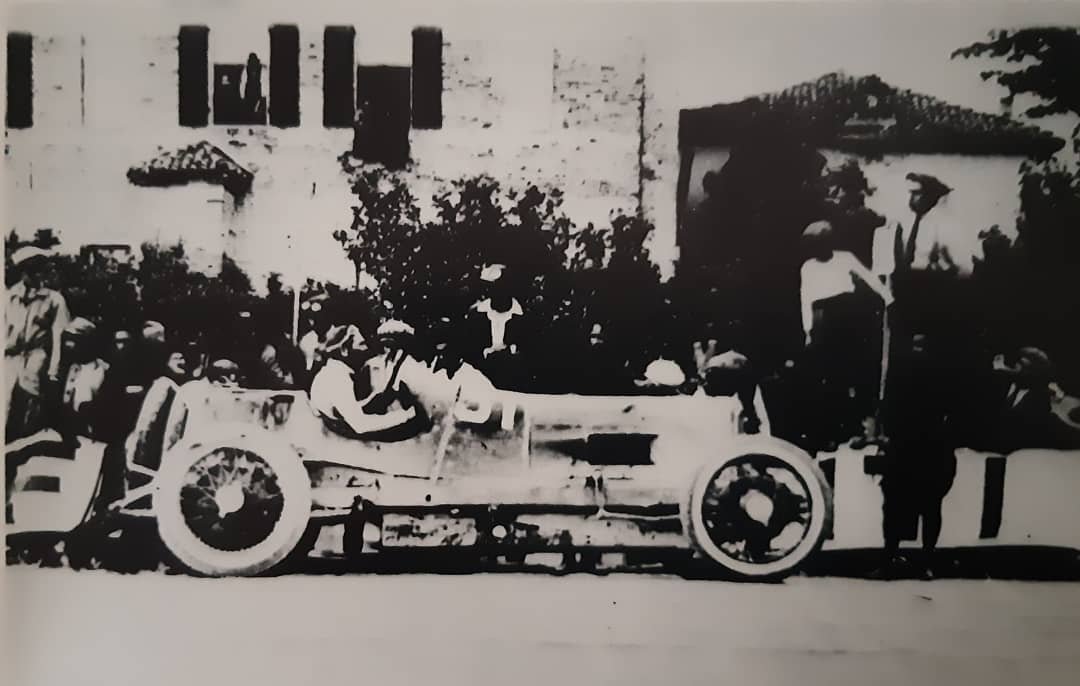
Complete Guide to Visiting the Basilica of Sant’Apollinare in Classe: Hours, Tickets, and Ravenna’s Historical Sites
Date: 14/06/2025
Introduction
Nestled in the tranquil suburb of Classe, just south of Ravenna, the Basilica of Sant’Apollinare in Classe stands as a crown jewel of early Christian and Byzantine art and architecture. Consecrated in 549 CE, the basilica boasts some of the most remarkable mosaics and is recognized as a UNESCO World Heritage Site. This comprehensive guide offers detailed insights into the basilica’s historical significance, architectural highlights, visiting hours, ticketing, accessibility, and travel tips—making it an essential resource for travelers, art lovers, and history enthusiasts.
For in-depth perspectives, consult reputable sources such as Smarthistory, UNESCO, and Sacred Destinations.
Historical Overview
Origins and Foundation
The basilica’s origins date to the early 6th century, when Ravenna served as a major center of political and ecclesiastical power in the Western Roman and Byzantine Empires. Built on the site of a Roman cemetery and former port, Sant’Apollinare in Classe was commissioned by Bishop Ursicinus and consecrated by Bishop Maximian in 549 CE (art-facts.com; thebyzantinelegacy.com). The church was dedicated to Saint Apollinaris, the first bishop of Ravenna and Christian martyr, whose relics are believed to be buried here.
Architectural Features
The basilica exemplifies early Christian basilican design: a long nave flanked by two side aisles, separated by 24 Greek marble columns with ornate capitals. The original structure included a narthex and atrium, and the interior is illuminated by 58 windows, creating a luminous atmosphere that highlights the mosaic artwork (Sacred Destinations). The cylindrical bell tower, added in the 9th or 10th century, is among the oldest of its kind in Italy.
Mosaic Masterpieces
Sant’Apollinare in Classe is famed for its breathtaking apse mosaic. At the center is a jeweled cross representing the Transfiguration of Christ, set against a starry sky and flanked by Moses and Elijah. Below, Saint Apollinaris is depicted in a lush paradise, surrounded by twelve lambs symbolizing the faithful (Smarthistory). The mosaic’s shimmering gold tesserae and vibrant colors exemplify the fusion of Western and Eastern artistic traditions characteristic of Ravenna’s monuments.
Elsewhere in the basilica, 7th-century mosaics depict scenes such as Emperor Constantine IV granting privileges to the church and Old Testament figures making sacrifices. The basilica also houses intricately carved early Christian sarcophagi that illustrate the evolution of funerary art (Sacred Destinations).
UNESCO World Heritage Status
In 1996, Sant’Apollinare in Classe was inscribed as part of the “Early Christian Monuments of Ravenna” UNESCO World Heritage Site (UNESCO). The basilica is recognized for its outstanding universal value, architectural purity, and its mosaics, which stand among the finest examples of Byzantine art in Western Europe.
Practical Visitor Information
Opening Hours
- Monday to Saturday: 8:30 am – 7:30 pm (last admission 7:00 pm)
- Sundays and religious holidays: 1:30 pm – 7:30 pm (last admission 30 minutes before closing)
- Closed: December 25th and during short maintenance periods in winter
Note: Hours may vary on holidays or for special events. Always check the official ticket portal for up-to-date information.
Tickets and Admission
- Standard ticket: €5
- Discounted ticket (EU citizens aged 18–25): €2
- Free admission: Children under 18, and on certain dates (e.g., first Sunday of the month, March 8, April 25, June 2, July 23)
- Combined tickets: Available for the basilica plus Classis Museum, Ancient Port of Classe, and other Ravenna sites (range: €9–€13)
- Purchase: Tickets can be bought on-site or online. Advance booking is recommended during high season and special events.
Accessibility
The basilica is fully accessible, with barrier-free entryways and accessible restrooms. Staff are available to assist guests with mobility needs.
Getting There
- Bus: Start Romagna line 176 from Ravenna’s central station (about 15 minutes)
- Taxi: 5-minute ride from city center
- Bicycle: Dedicated cycle paths connect Classe to Ravenna
- Train: Classe station is a short walk (350–400 meters) from the basilica
- Car: Ample free parking nearby
Facilities and Amenities
- On-site restrooms
- Parking and clear signage
- Restaurants, shops, and hotels in Classe
- Pets are not allowed inside the basilica (except service animals)
Guided Tours and Group Visits
Guided tours are highly recommended for a deeper appreciation of the basilica’s art and history. Certified guides are available for private and group visits, and many tours also include nearby sites such as the Classis Museum and Ancient Port of Classe. Advance booking is advised for groups and during cruise excursions.
Photography and Visitor Etiquette
- Photography is permitted without flash or tripods
- Modest dress is required; the basilica is an active place of worship
- Please maintain a respectful demeanor during religious services
Special Events and Highlights
- Saint Patron’s Day (July 23): Special ceremonies and free admission
- Notte d’Oro (Golden Night): Evening events and extended opening hours
- Seasonal concerts: Take advantage of the basilica’s excellent acoustics
Photographic highlights:
- The apse mosaic depicting Christ and Saint Apollinaris (alt: “Detail of apse mosaic in Basilica of Sant’Apollinare in Classe”)
- Nave columns and capitals (alt: “Greek marble columns with carved capitals inside the basilica”)
- Exterior bell tower and façade (alt: “Cylindrical campanile bell tower, Basilica of Sant’Apollinare in Classe”)
Nearby Attractions
- Classis Museum: Archaeological museum (350–400 meters from the basilica)
- Ancient Port of Classe: Open-air archaeological park (2 km away)
- Other Ravenna UNESCO Sites: Including Basilica of San Vitale and Mausoleum of Galla Placidia
- Suggested itinerary: Combine sites for a full-day exploration of Ravenna’s Christian and maritime heritage
Frequently Asked Questions (FAQ)
Q: Can I buy tickets on-site?
A: Yes, but online booking is recommended during peak periods.
Q: Is the basilica wheelchair accessible?
A: Yes, it is fully accessible.
Q: Are guided tours available?
A: Yes, both group and private tours are offered.
Q: Can I bring pets?
A: Only service animals are allowed inside.
Q: When is the best time to visit?
A: Weekday mornings or late afternoons, especially outside peak seasons.
Conclusion
The Basilica of Sant’Apollinare in Classe is a must-visit for anyone interested in Italy’s early Christian heritage, art, and architecture. Its harmonious blend of Roman structure and Byzantine mosaics, serene setting, and accessibility make it ideal for both casual visitors and scholars. Plan ahead by booking tickets online, consider a guided tour for expert insights, and explore the surrounding archaeological treasures for a comprehensive Ravenna experience.
For up-to-date information, tickets, and combination offers, visit the RavennAntica website or the Visit Italy portal.
Enhance your journey with the Audiala app for audio guides and real-time updates, and follow us on social media for exclusive tips and virtual tours.
References
- Basilica of Sant’Apollinare in Classe Facts (art-facts.com)
- The Byzantine Legacy: Sant’Apollinare in Classe
- Sacred Destinations: Basilica of Sant’Apollinare in Classe
- Smarthistory: Sant’Apollinare in Classe, Ravenna, Italy
- UNESCO World Heritage Centre: Early Christian Monuments of Ravenna
- Wikipedia: Basilica of Sant’Apollinare in Classe
- Ministero della Cultura: Museums and Cultural Heritage in Ravenna
- Hellenic News: Memories of Italy – Basilica of Sant’Apollinare in Classe
- Italy Beyond the Obvious: The Mosaics in Ravenna

